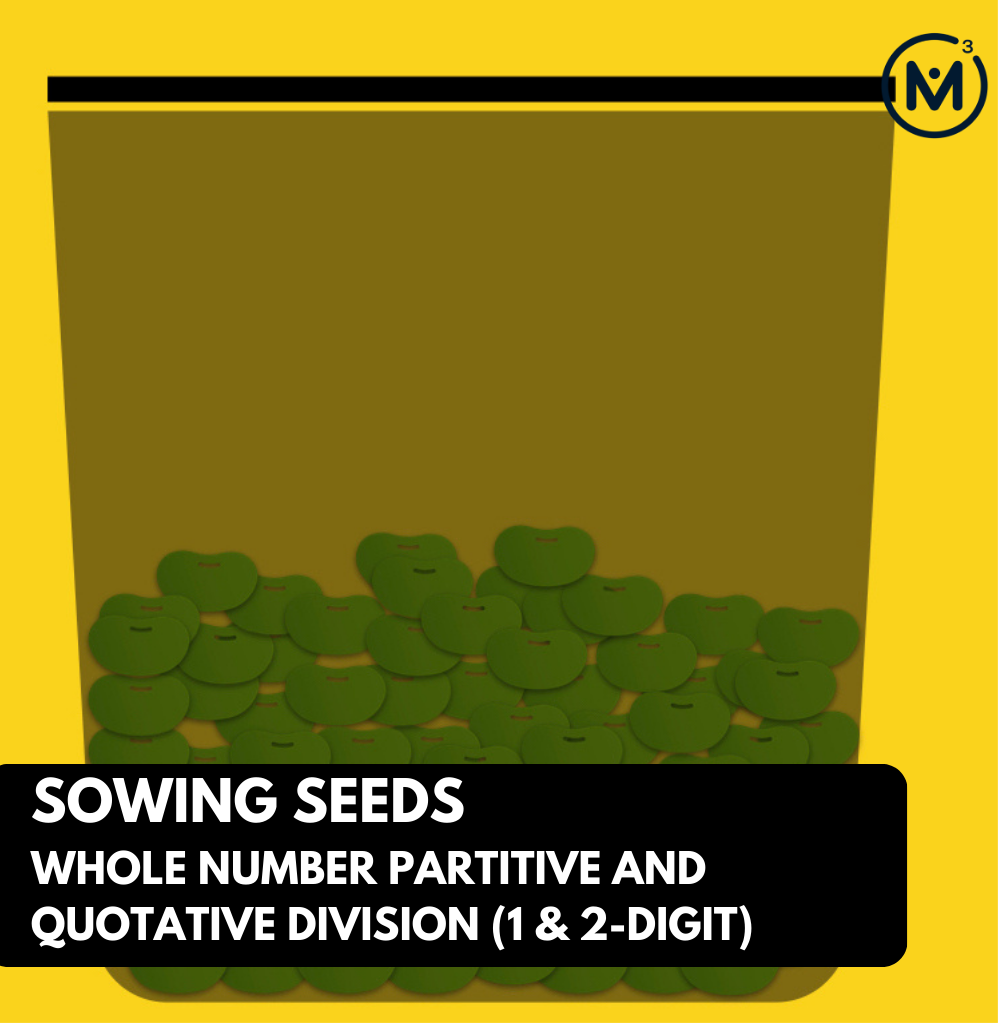SOWING SEEDS [DAY 5]
Whole Number Partitive and Quotative Division (1 & 2-Digit)
Introduction to partitive and quotative division. This unit is designed to support students in understanding the two types of division and should be considered before exploring all other division units.
Intentionality
Math Talk
Assessment
Resources & Downloads
Educator Discussion Area
Intentionality & Unit Overview

Length of Unit: 5 Days
Access each lesson from this unit using the navigation links below
Students will demonstrate the concepts and skills that they have developed through this context and learning experience.
Intentionality…
The purpose of this assessment is for students to demonstrate their understanding of the following big ideas.
- There are two types of division;
- Partitive division is when the total quota is known (the dividend), and the number of parts or groups (the divisor) is known;
- Partitive division reveals a rate;
- In partitive division, the dividend and the divisor often have different units;
- In a quotative context, the dividend and the divisor have the same unit;
- Quotative division is when the total quota is known (the dividend), and the number per group or the rate (the divisor) is known;
- Quotative division reveals the number of copies or iterations of a rate that can be derived from the overall quota (the dividend);
- The dividend and the divisor of any division sentence represent a ratio;
- In a partitive context, the ratio is often a composed unit;
- In a quotative context, the ratio is a multiplicative comparison;
- The dividend from any division sentence can be decomposed into smaller parts to allow for friendlier division by the divisor. This strategy is known as partial quotients. (i.e.: 85 ÷ 5 = 45 ÷ 5 + 40 ÷ 5 = 9 + 8 = 17).
- The remainder can be divided by the dividend resulting in a fraction in both partitive and quotative division contexts, unless the unit is discrete and cannot be partitioned (for example, a marble or a person).
The independent assessment will allow students to demonstrate concepts and skills related to the following learning goals:
- I will explain the difference between partitive and quotative division.
- I will model both partitive and quotative division.
- I will solve division problems using appropriate strategies.
- I will explain what to do with the remainder.
- I will use appropriate vocabulary, such as ratio, rate, dividend, divisor and quotient.
Students might write and/or model their answers independently. Students can also be interviewed by their teacher.
An alternative assessment opportunity should be offered if this tool will not successfully capture what the student knows, understands or can do.
Math Talk
Login/Join to access the entire Teacher Guide, downloadable slide decks and printable handouts for this lesson and all problem based units.
Assessment
Assessment Considerations…
Login/Join to access the entire Teacher Guide, downloadable slide decks and printable handouts for this lesson and all problem based units.
Assessment: Dividing whole numbers through partitive and quotative division
Login/Join to access the entire Teacher Guide, downloadable slide decks and printable handouts for this lesson and all problem based units.
Considerations to Promote Student Growth
Login/Join to access the entire Teacher Guide, downloadable slide decks and printable handouts for this lesson and all problem based units.
Resources & Downloads
Login/Join to access the entire Teacher Guide, downloadable slide decks and printable handouts for this lesson and all problem based units. Or purchase the entire unit.
Educator Discussion Area
Login/Join to access the entire Teacher Guide, downloadable slide decks and printable handouts for this lesson and all problem based units.
Explore Our 60+ Problem Based Units
This Make Math Moments Lesson was designed to spark curiosity for a multi-day unit of study with built in purposeful practice, number talks and extensions to elicit and emerge strategies and mathematical models.
Dig into our other units of study and view by concept continuum, grade or topic!


